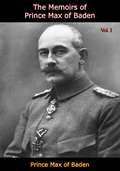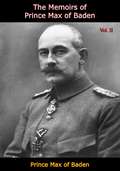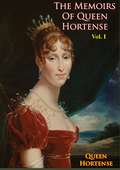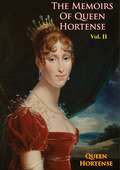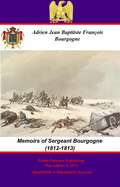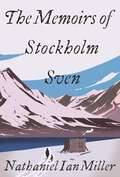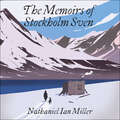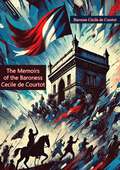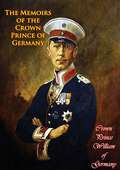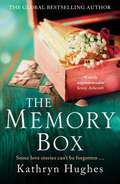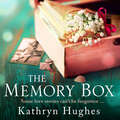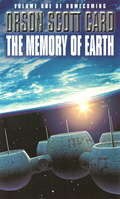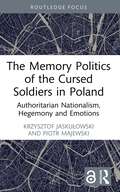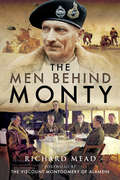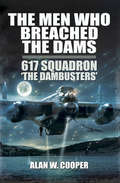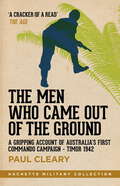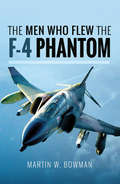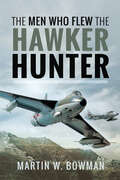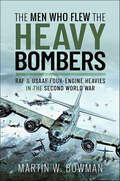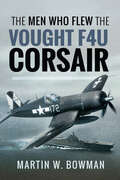- Table View
- List View
The Memoirs of Prince Max of Baden Vol. I (The Memoirs of Prince Max of Baden #1)
by Prince Max of Baden Baden W. M. CalderThis is Volume I of II comprising the authorized translation of Prince Max of Baden’s German memoirs published in 1927 (original German title: Erinnerungen und Dokumente). This translation was first published in 1928.“NOT long after the Revolution, when it became clear that an essential share of the blame for the German collapse would be ascribed to me, I decided to give a public account of my stewardship. I soon realized that I could only explain the actual connection of events both to the German people and to myself if I submitted the charges made against me to a careful examination, and also made up my mind to understand the point of view of my opponents.“As early as 1919 I found myself compelled to define my attitude to the disputed happenings of 9th November. I did this in a publication which was printed in all the newspapers but was virtually hushed up in the controversial literature.“In the study and self questioning of eight years I think I have got as near the truth as I can.“In the course of my work my apologia has grown into something different—an account based on original sources of that fateful epoch of the history of Germany in which I was involved. I put my trust in the weight of the facts.” (Prince Max of Baden)
The Memoirs of Prince Max of Baden Vol. II (The Memoirs of Prince Max of Baden #2)
by Prince Max of Baden Baden W. M. CalderThis is Volume II of II comprising the authorized translation of Prince Max of Baden’s German memoirs published in 1927 (original German title: Erinnerungen und Dokumente). This translation was first published in 1928.“NOT long after the Revolution, when it became clear that an essential share of the blame for the German collapse would be ascribed to me, I decided to give a public account of my stewardship. I soon realized that I could only explain the actual connection of events both to the German people and to myself if I submitted the charges made against me to a careful examination, and also made up my mind to understand the point of view of my opponents.“As early as 1919 I found myself compelled to define my attitude to the disputed happenings of 9th November. I did this in a publication which was printed in all the newspapers but was virtually hushed up in the controversial literature.“In the study and self questioning of eight years I think I have got as near the truth as I can.“In the course of my work my apologia has grown into something different—an account based on original sources of that fateful epoch of the history of Germany in which I was involved. I put my trust in the weight of the facts.” (Prince Max of Baden)
The Memoirs of Queen Hortense Vol. I (The Memoirs of Queen Hortense #1)
by Jean Hanoteau Arthur Kingsland Griggs Queen Hortense Eugénie Cécile BonaparteIn presenting to the public the Memoirs of Queen Hortense exactly as she recorded them, in exposing it to scholars--with an intrinsic and absolute respect for the integral historical accuracy of the text--these intimate revelations as set down by her royal hand, Prince Napoleon did a service not only to history but also to the memory of a princess too often harshly criticized eminently French in her heart and mind, to the memory of an unfortunate Queen, to the memory of an exquisite woman.Like the Emperor, one of whose shadows she was and whose touching and affectionate farewell smile she received as he was leaving France for the last time, the Queen of Holland has nothing to lose by having all her acts and even her mistakes fully revealed.This becomes very clear as one peruses these volumes where she took care not to avoid any of the difficulties of her task. She knew what society said about her; she was aware of the reproaches, justified and unjustified, of which she was the object. Frequently, reading between the lines one is conscious of the care her pen took to refute certain implications, sometimes with disdain but never without courage.
The Memoirs of Queen Hortense Vol. II (The Memoirs of Queen Hortense #2)
by Jean Hanoteau Arthur Kingsland Griggs Queen HortenseIn presenting to the public the Memoirs of Queen Hortense exactly as she recorded them, in exposing it to scholars--with an intrinsic and absolute respect for the integral historical accuracy of the text--these intimate revelations as set down by her royal hand, Prince Napoleon did a service not only to history but also to the memory of a princess too often harshly criticized eminently French in her heart and mind, to the memory of an unfortunate Queen, to the memory of an exquisite woman.Like the Emperor, one of whose shadows she was and whose touching and affectionate farewell smile she received as he was leaving France for the last time, the Queen of Holland has nothing to lose by having all her acts and even her mistakes fully revealed.This becomes very clear as one peruses these volumes where she took care not to avoid any of the difficulties of her task. She knew what society said about her; she was aware of the reproaches, justified and unjustified, of which she was the object. Frequently, reading between the lines one is conscious of the care her pen took to refute certain implications, sometimes with disdain but never without courage.
The Memoirs of Sergeant Bourgogne (1812-1813)
by Anon Pickle Partners Publishing Sergeant Adrien Jean Baptiste François BourgogneThis ebook is purpose built and is proof-read and re-type set from the original to provide an outstanding experience of reflowing text for an ebook reader. Considered by the majority of commentators to be the quintessential personal narrative of Napoleon's disastrous 1812 campaign in Russia. The book charts the progress of the Grande Armée toward it's apogee at the occupation of Moscow, followed by the great fire of Moscow and the looting of the city to the terrible retreat. During the retreat the full horror of the hunger, privation are vividly depicted, not only in Bourgogne's own sufferings, but also those of his friends and countrymen. He stumbles through trials that proved too much for most those around him, whilst maintaining a haunting ability to describe the torments that try him. This account written partly in captivity in 1813, after capture at the battle of Dessau in 1813 and partly from letters he sent to his family during 1812, its historical significance and value cannot be over stated. Text taken from book published in 1899 by William Heinemann, London
The Memoirs of Stockholm Sven
by Nathaniel Ian MillerLonglisted for the Center for Fiction's 2021 First Novel Prize'Picaresque, gentle and slyly humorous; the glacial beauty of the northern landscape is the backdrop to arresting horrors, concealed passions, and a lifetime of kindnesses - all superbly rendered by Miller: a joy to read' Oisin Fagan, author of NobberIn 1916, Sven Ormson leaves Stockholm to seek adventure in Svalbard, an Arctic archipelago where darkness reigns four months of the year, and where he might witness the splendour of the Northern Lights one night or be attacked by a polar bear the next. After a devastating accident while digging for coal, Sven heads north again and ends up on an uninhabited fjord living in a hut he builds, alone except for the company of a loyal dog, testing himself against the elements. Years into his routine isolation, the arrival of an unlikely visitor sparks a chain of events that brings Sven into a family of fellow outsiders and determines the course of the rest of his life. Inspired by a real person and written with wry humour, in prose as beautiful as the stark landscape it evokes, The Memoirs of Stockholm Sven is a testament to the strength of human bonds, reminding us that even in the most inhospitable conditions, we are not beyond the reach of love.
The Memoirs of Stockholm Sven
by Nathaniel Ian MillerSet in the decades between the two World Wars, the captivating story of one man who banishes himself to a solitary life in the Arctic Circle, and is saved by good friends, a loyal dog, and a surprise visit that changes everything.In 1916, Sven Ormson leaves Stockholm to seek adventure in Svalbard, an Arctic archipelago where darkness reigns four months of the year, where he might witness the splendor of the Northern Lights one night or be attacked by a polar bear the next. After a devastating accident while digging for coal, Sven heads north again and ends up on an uninhabited fjord living in a hut he builds, alone except for the company of a loyal dog, testing himself against the elements. Years into his routine isolation, the arrival of an unlikely visitor sparks a chain of events that brings Sven into a family of fellow castoffs and determines the course of the rest of his life. Inspired by a real life character and written with wry humour, in prose as beautiful as the stark landscape it evokes, The Memoirs of Stockholm Sven is a testament to the strength of human bonds, reminding us that even in the most inhospitable conditions, we are not beyond the reach of love.(P) 2021 Hodder & Stoughton Limited
The Memoirs of Stockholm Sven
by Nathaniel Ian MillerThe &“captivating&’&’ and &“powerful&’&’ story (Publishers Weekly, starred review) of one man who banishes himself to a solitary life in the Arctic Circle, and is saved by good friends, a loyal dog, and a surprise visit that changes everything, in a novel that is both &“ceaselessly brilliant&’&’ (Adam Johnson, Pulitzer Prize–winning author of The Orphan Master&’s Son) and &“pure delight&’&’ (Christina Baker Kline, #1 bestselling author of Orphan Train)#1 INDIE NEXT PICKLonglisted for the Center for Fiction First Novel PrizeIn 1916, Sven Ormson leaves a restless life in Stockholm to seek adventure in Svalbard, an Arctic archipelago where darkness reigns four months of the year and he might witness the splendor of the Northern Lights one night and be attacked by a polar bear the next. But his time as a miner ends when an avalanche nearly kills him, leaving him disfigured, and Sven flees even further, to an uninhabited fjord. There, with the company of a loyal dog, he builds a hut and lives alone, testing himself against the elements. The teachings of a Finnish fur trapper, along with encouraging letters from his family and a Scottish geologist who befriended him in the mining camp, get him through his first winter. Years into his routine isolation, the arrival of an unlikely visitor salves his loneliness, sparking a chain of surprising events that will bring Sven into a family of fellow castoffs and determine the course of the rest of his life. Written with wry humor and in prose as breathtaking as the stark landscape it evokes, The Memoirs of Stockholm Sven is a testament to the strength of our human bonds, reminding us that even in the most inhospitable conditions on the planet, we are not beyond the reach of love.
The Memoirs of the Baroness Cecile de Courtot, Lady-in-waiting to the Princess de Lamballe, Princess of Savoy-Carignan
by Baronne Cécile de Courtot Anna Gottliebe Luise Wilhelmine von AlvenslebenImmerse yourself in the opulent and tumultuous world of 18th-century French aristocracy with "The Memoirs of the Baroness Cecile de Courtot, Lady-in-waiting to the Princess de Lamballe, Princess of Savoy-Carignan." This captivating memoir offers a firsthand account of life at the royal court, revealing the personal experiences and historical events that shaped the lives of the French nobility during a period of great upheaval.Baronne Cécile de Courtot, an esteemed lady-in-waiting, provides an intimate and detailed narrative of her service to the Princess de Lamballe, a close confidante of Marie Antoinette and a prominent figure at the French court. Through the Baroness's keen observations and engaging storytelling, readers gain a unique perspective on the inner workings of the royal household, the intrigues and romances of court life, and the dramatic events leading up to the French Revolution."The Memoirs of the Baroness Cecile de Courtot" delves into the Baroness's close relationship with the Princess de Lamballe, offering insights into the Princess's character, her dedication to the royal family, and her tragic fate during the Revolution. The memoir also captures the broader social and political landscape of the time, providing a vivid portrayal of the opulence of the court juxtaposed with the growing unrest among the populace.Rich with historical detail and personal reflections, this memoir brings to life the elegance, charm, and peril of the French court. The Baroness's eloquent prose and poignant recollections offer readers a window into a world of grandeur and danger, making this a compelling read for history enthusiasts and lovers of memoirs alike."The Memoirs of the Baroness Cecile de Courtot" is an essential resource for anyone interested in the history of the French aristocracy and the dramatic events of the late 18th century. This remarkable memoir not only preserves the legacy of the Princess de Lamballe but also provides a lasting tribute to the resilience and courage of those who lived through one of the most turbulent periods in French history.Join Baronne Cécile de Courtot as she recounts her extraordinary life and the unforgettable events she witnessed, offering a rare and intimate portrait of the French court at the brink of revolution.
The Memoirs of the Crown Prince of Germany
by Crown Prince William of GermanyBecause of his foppish and dandified appearance, emphasised by the cigarette holder he always used, the Crown Prince was regarded by the British during the Great War as a figure of ridicule, known to them as Little Willy. He was born in Potsdam on 6 May 1882, the eldest of Kaiser, and his memoirs begin with his childhood and early years and the development of his relations with his father, a somewhat remote figure…When war came he was given command of the Fifth Army with General Schmidt von Knobelsdorf as his chief of staff, and it was his army that launched the Verdun offensive in February 1916. As you read on the more it becomes clear that he was, in fact, far from his caricature. He was well aware of the enormous prestige attached to his person as son of the All-Highest and he did not hesitate to make use of it, in the political and military scene. He played no small part in the downfall of the Chancellor, von Bethman Hollweg, in 1917. In the aftermath of Ludendorff’s resignation he urged the Kaiser not to appoint Groener in his place, a man he regarded as a defeatist whom he disliked and mistrusted. He also maintained that the German army was not defeated at the Marne; it was withdrawn by its leaders. The battle was lost because the High Command gave it up as lost. When Moltke’s emissary, Lt Col von Hentsch, doing his rounds of the Army commanders ordering them to fall back, arrived at Fifth Army HQ, the Crown Prince refused point blank to comply without a written authority, which Hentsch did not have. And even when von Moltke himself turned up, struggling to repress his tears and demanded the instant withdrawal of Fifth Army, Wilhelm, after a lengthy argument still refused to go until he was ready. Moltke, apparently, left in tears. The imagination boggles at the thought of Haig tearfully imploring Rawlinson to obey orders, and the latter standing there, arms folded and saying: ‘Shan’t!’-Print ed.
The Memory Box: A heart-breaking historical novel set partly in World War Two, inspired by true events, from the global bestselling author
by Kathryn HughesSome love stories last a lifetime...'UTTERLY UNPUTDOWNABLE' Jenny Ashcroft'Wow, wow, wow!!! The BEST BOOK I have read all year. A gorgeous story which had me hooked. Make sure you have a box of tissues when you read this beautiful story ⭐ ⭐ ⭐ ⭐ ⭐'_______From the million-copy-bestselling author of The Letter, Kathryn Hughes, and inspired by true events, an unforgettable, moving and timeless story of love and war which will stay with you for ever. Readers who adored The Nightingale, The Notebook or The Tattooist of Auschwitz will love to unlock The Memory Box...Jenny Tanner opens the box she has cherished for decades. Contained within are her most precious mementoes, amongst them a pebble, a carving and a newspaper cutting she can hardly bear to read. But Jenny knows the time is finally here. After the war, in a mountainside village in Italy, she left behind a piece of her heart. However painful, she must return to Cinque Alberi. And lay the past to rest.After a troubled upbringing, Candice Barnes dreams of a future with the love of her life - but is he the man she believes him to be? When Candice is given the opportunity to travel to Italy with Jenny, she is unaware the trip will open her eyes to the truth she's been too afraid to face. Could a place of goodbyes help her make a brave new beginning?_______Will you be the next reader to lose your heart to The Memory Box?'A heartbreaking and heartwarming tale of love, loss and forgiveness' Daily Mail'A spellbinding tale with lots of surprises and endearing characters. Hughes is a wonderful storyteller' Woman's Weekly'I could not put this book down! It is absolutely phenomenal from the very first page... it is heartbreaking, joyful and hopeful ⭐ ⭐ ⭐ ⭐ ⭐''I've loved every single one of Kathryns' books, but this one was my absolute favourite! ⭐ ⭐ ⭐ ⭐ ⭐''The twist at the end made me gasp! ⭐ ⭐ ⭐ ⭐ ⭐''I absolutely loved this book. Devoured it in a few days. I eagerly await more of Kathryn Hughes' books. I will be first in line. Excellent ⭐ ⭐ ⭐ ⭐ ⭐''What a gorgeously written tale... heartbreaking but also heartwarming. Full of unexpected twists, this one had me gripped! ⭐ ⭐ ⭐ ⭐ ⭐''A stunningly beautiful story. Brilliantly developed characters. A heart-warming and emotional read that I read in one sitting ⭐ ⭐ ⭐ ⭐ ⭐''A heartwarming, well-written story. Heartbreaking in places but a story that had to be told ⭐ ⭐ ⭐ ⭐ ⭐'
The Memory Box: A heart-breaking historical novel set partly in World War Two, inspired by true events, from the global bestselling author
by Kathryn HughesSome love stories last a lifetime...'UTTERLY UNPUTDOWNABLE' Jenny Ashcroft'Wow, wow, wow!!! The BEST BOOK I have read all year. A gorgeous story which had me hooked. Make sure you have a box of tissues when you read this beautiful story ⭐ ⭐ ⭐ ⭐ ⭐'_______From the million-copy-bestselling author of The Letter, Kathryn Hughes, and inspired by true events, an unforgettable, moving and timeless story of love and war which will stay with you for ever. Readers who adored The Nightingale, The Notebook or The Tattooist of Auschwitz will love to unlock The Memory Box...Jenny Tanner opens the box she has cherished for decades. Contained within are her most precious mementoes, amongst them a pebble, a carving and a newspaper cutting she can hardly bear to read. But Jenny knows the time is finally here. After the war, in a mountainside village in Italy, she left behind a piece of her heart. However painful, she must return to Cinque Alberi. And lay the past to rest.After a troubled upbringing, Candice Barnes dreams of a future with the love of her life - but is he the man she believes him to be? When Candice is given the opportunity to travel to Italy with Jenny, she is unaware the trip will open her eyes to the truth she's been too afraid to face. Could a place of goodbyes help her make a brave new beginning?_______Will you be the next reader to lose your heart to The Memory Box?'A heartbreaking and heartwarming tale of love, loss and forgiveness' Daily Mail'A spellbinding tale with lots of surprises and endearing characters. Hughes is a wonderful storyteller' Woman's Weekly'I could not put this book down! It is absolutely phenomenal from the very first page... it is heartbreaking, joyful and hopeful ⭐ ⭐ ⭐ ⭐ ⭐''I've loved every single one of Kathryns' books, but this one was my absolute favourite! ⭐ ⭐ ⭐ ⭐ ⭐''The twist at the end made me gasp! ⭐ ⭐ ⭐ ⭐ ⭐''I absolutely loved this book. Devoured it in a few days. I eagerly await more of Kathryn Hughes' books. I will be first in line. Excellent ⭐ ⭐ ⭐ ⭐ ⭐''What a gorgeously written tale... heartbreaking but also heartwarming. Full of unexpected twists, this one had me gripped! ⭐ ⭐ ⭐ ⭐ ⭐''A stunningly beautiful story. Brilliantly developed characters. A heart-warming and emotional read that I read in one sitting ⭐ ⭐ ⭐ ⭐ ⭐''A heartwarming, well-written story. Heartbreaking in places but a story that had to be told ⭐ ⭐ ⭐ ⭐ ⭐'
The Memory Box: An absolutely heartbreaking WW2 novel about love against the odds, based on a true story
by Kathryn HughesA heartbreakingly beautiful novel, The Memory Box unlocks an unforgettable epic story of love and war, from the million-copy-selling author of The Letter, Kathryn Hughes. If you adored The Nightingale, The Tuscan Contessa or My Name is Eva, this is the book for you. Some love stories can't be forgotten...Jenny Tanner opens the box she has cherished for decades. Contained within are her most precious mementoes, amongst them a pebble, a carving and a newspaper cutting she can hardly bear to read. But Jenny knows the time is finally here. After the war, in a mountainside village in Italy, she left behind a piece of her heart. However painful, she must return to Cinque Alberi. And lay the past to rest.After a troubled upbringing, Candice Barnes dreams of a future with the love of her life - but is he the man she believes him to be? When Candice is given the opportunity to travel to Italy with Jenny, she is unaware the trip will open her eyes to the truth she's been too afraid to face. Could a place of goodbyes help her make a brave new beginning?(P)2021 Headline Publishing Group Limited
The Memory Of Earth: Homecoming Series: Book 1 (Homecoming #1)
by Orson Scott CardHaunting, compulsive, urgently readable...Storytelling genius - INTERZONECertain to be one of the most soughtafter books of the year - LOCUSThe planet called Harmony had been settled by humans nearly forty years before. The colony had been placed under the care of an artificial intelligence, the Oversoul, high in orbit. This master computer had one overriding command: guard the people of Harmony.But now the Oversoul is itself in danger. Soon, within a thousand years, catastrophic war will break out on Harmony unless the Oversoul can be repaired. The master computer has determined that it must be taken back to lost Earth; someone on Harmony must be given back the knowledge of space travel in order to save the planet from destruction. For one family, about to be caught up in an approaching civil war, life will change for ever.The first book in the brilliant Homecoming series.Books by Orson Scott Card:Alvin Maker novelsSeventh SonRed ProphetPrentice AlvinAlvin JourneymanHeartfireThe Crystal CityEnder Wiggin SagaEnder's GameSpeaker for the DeadXenocideChildren of the MindEnder in ExileHomecomingThe Memory of the EarthThe Call of the EarthThe Ships of the EarthEarthfallEarthbornFirst Formic War (with Aaron Johnston)Earth UnawareEarth AfireEarth Awakens
The Memory Politics of the Cursed Soldiers in Poland: Authoritarian Nationalism, Hegemony and Emotions (Routledge Focus on the History of Conflict)
by Krzysztof Jaskułowski Piotr MajewskiThis book analyses right-wing memory politics in Poland through the concept of "cursed soldiers" as a key memory symbol, and how it has been used to construct a narrow and exclusionary vision of Polish identity framed in terms of Catholicism, national culture, and traditional family values.Groundbreaking in its approach and combining top-down study with reception analysis, the book builds on the theory of hegemony, adding emotional dimensions to the understanding of memory politics and nationalism. It provides a detailed case study of Polish memory politics since 2015, when the Law and Justice Party (PiS) came to power, and offers insights into how historical memory is used to mobilise support within nationalist and populist movements. Through a range of data including interviews, participant observation, and analysis of various media, it presents a semiotic and emotional map of how these memory symbols are received and experienced in Polish society. The focus on Podlasie, a region with significant Belarusian population and a history of post-war partisan conflicts, highlights the complex interplay of memory, identity, and politics in contemporary Poland.This work is intended for a broad audience, including undergraduates, postgraduates, scholars, and non-specialist readers such as booksellers or librarians.
The Memory Wood
by Sam LloydA heart-stopping, chilling thriller about an abducted girl, the boy who can save her and the terrifying cat-and-mouse game of deception and betrayal that they are playing."If you've only just arrived . . . then why do you want to leave?"Elissa arrived in Memory Wood on the most important day of her life. The thirteen-year-old chess prodigy was competing at the English Youth Grand Prix when she was snatched, and then woke up in a makeshift cell underground.Elijah has lived beside Memory Wood for as long as he can remember. He's only twelve but he's spent his life so far exploring every inch of it, and that's how he finds Elissa.When he appears in her cell, Elissa assumes Elijah will help her; that he'll go to the police and give them the answers they desperately need. But Elijah doesn't want her to leave. As her abductor's behaviour becomes increasingly erratic, Elijah's company is soon her only source of relief and Elissa realizes that this strange, lonely boy is her one hope for survival. Drawing on all her resilience and powers of logic to outwit him, their deadly game of cat and mouse, of deception and betrayal, but also their bond of friendship, will determine both their fates. . . .
The Memory of the Second World War in Soviet and Post-Soviet Russia (Routledge Histories of Central and Eastern Europe)
by David L. HoffmannThis volume showcases important new research on World War II memory, both in the Soviet Union and in Russia today. Through an examination of war remembrance in its various forms—official histories, school textbooks, museums, monuments, literature, films, and Victory Day parades—chapters illustrate how the heroic narrative of the war was established in Soviet times and how it continues to shape war memorialization under Putin. This war narrative resonates with the Russian population due to decades of Soviet commemoration, which continued virtually uninterrupted into the post-Soviet period. Major themes of the volume include the use of World War II memory for political legitimation and patriotic mobilization; the striking continuities between Soviet and post-Soviet commemorative practices; the place of Holocaust memorialization in contemporary Russia; Putin’s invocation of the war to bolster national pride and international prestige; and the relationship between individual memory and collective remembrance. Authored by an international group of distinguished specialists, this collection is ideal for scholars of Russia across a range of disciplines, including history, political science, sociology, and cultural studies.
The Men Behind Monty
by Richard MeadThe Men Behind Monty examines the role played by the staff in the victorious campaigns of Field Marshal Viscount Montgomery, Britain's most successful field commander since the Duke of Wellington.When Monty took command of Eighth Army in August 1942, he inherited the staff of his predecessor. He retained all the key members and most of them stayed with him not only from El Alamein to Tunis, but also in Sicily and Italy. When he took command of 21st Army Group in January 1944, many accompanied him to take up the most prominent positions on the HQ staff and the majority remained until the German surrender in May 1945.This fascinating work focuses not only on the senior officers responsible for the various staff branches, and notably on Monty's outstanding Chief of Staff, Freddie de Guingand, but also on his personal staff, the ADCs and personal liaison officers.The book sheds light on the work of the staff generally, and on their direct contribution to Monty's decisions, his sometimes difficult and controversial relationships with his superiors and allies.
The Men Who Breached the Dams: 617 Squadron 'The Dambusters (Airlife Classics Ser.)
by Alan W. CooperFirst published to acclaim in 1982, this was author Alan Cooper's first publication before he went on to become a prolific writer of aviation history. As we approach the 70th Anniversary of the Dam Buster Raids, this re-print will make a timely addition to the library of any enthusiast wishing to mark the occasion, and any curious readers who wish to expand their knowledge of this key operation in World War II history. Painstaking research went into every aspect of an operation, which at the time and ever since has captured the imagination of the world. This forms an evocative history of one of the most successful operations of the Second World War carried out by the famous 617 Squadron and led by Guy Gibson. This account includes the whole lead up to the final mission; the development of the bouncing bomb, the forming of 617 Squadron and the intense course of training carried out to make the operation a success. The raid itself is viewed from both British and German camps; many of the aircrew who took part in 617 operations give their accounts, as do several Germans, including Albert Speer, the Armaments minister. There is a remarkable eyewitness account of the raid from a man who was a gunner on the Mohne dam itself, telling of the damage after the raid and how he and his companions shot down one of the attacking aircraft. The investigation is completed by an in-depth study into the effects of the operation, how far it proved successful and the true extent of the devastation it caused. Overall, the book recreates the excitement and aura of danger and uncertainty, which surrounded the Dam busters' mission, giving the reader the full story of one of the greatest episodes of the war. 'A fascinating record which will be difficult to better' Group Captain W.S.O. Randle, Aerospace
The Men Who Came Out of the Ground: A Gripping Account of Australia's First Commando Campaign
by Paul Cleary'This account . . . is breathtaking in its scope and riveting in its research' - Sydney Morning HeraldThe gripping story of a small force of Australian Special Forces commandos that launched relentless hit and run raids on far superior Japanese forces in East Timor for most of 1942.These Australians were the men of the 2/2nd Australian Independent Company - a special commando unit. Initially stranded without radio contact to Australia, the Japanese declared these bearded warriors `outlaws? and warned they would be executed immediately if captured. The Australians drawn mainly from the bush, were chosen for their ability to operate independently and survive in hostile territory. As film-maker Damien Parer said after visiting in Timor in late 1942, `these men are writing an epic of guerrilla warfare?.Expertly researched by Paul Cleary, who is fluent in Tetum, the main language of the indigenous group of East Timor, it also contains insightful black and white photos.'A cracker of a read' - The Age'Paul Cleary has brought to life one of the great success stories of World War II' - Daily Telegraph
The Men Who Flew the F-4 Phantom
by Martin W. BowmanThe Phantom was developed for the US Navy as a long-range all-weather fighter and first flew in May 1958, before becoming operational in 1961. The US Air Force then realized that the Navy had an aircraft that was far better than any tactical aircraft in their inventory and ordered 543 F-4C variants. There then followed a spate of orders from around the world. In Britain, it was ordered for the Navy and Air Force, but was modified to take the Rolls-Royce Spey turbofan. One of the Royal Navy's Phantoms stole the record for the fastest Atlantic crossing, a record that stood until taken by the remarkable Blackbird. Phantoms have been used in combat in many conflicts throughout its long service history. It was one of America's most utilized aircraft during the long Vietnam War and has been flown in anger in the Middle East by a number of different air forces.This is the perfect book for the general reader, enthusiast or modeler wishing to find a succinct yet detailed introduction to the design of the aircraft that has made history. It features a multitude of stories as relayed by USAF and Israeli airmen who actually flew this remarkable aircraft in wars in SE Asia and the Middle East, detailing just what it was like to fly the F-4 in combat. Many of the dozen or so chapters include combat testimonies of the Phantom design and durability in SE Asia and in the wars fought between Israel and her surrounding Arab enemies throughout the 1970s and beyond.The book also features a wealth of technical data along with stirring images that supplement the text perfectly, enhancing its visual appeal.
The Men Who Flew the Hawker Hunter
by Martin W. BowmanFeatures a wealth of first-hand testimony drawn from pilots who flew the outstanding Hawker Hunter.If ever there was a real pilot's aeroplane it was the Hunter, an outstanding multi-purpose aircraft which excelled in the roles of interceptor fighter, ground attack, reconnaissance, research vehicle and two-seater trainer, not to mention its dramatic displays in formation aerobatic performances. The Hawker Hunter is one of the world's greatest aircraft. For decades pilots have enthused about it, extolling the virtues of its smooth, aerodynamic lines, 4 x 30mm cannon, Rolls-Royce Avon engine, and its outstandingly honest handling characteristics combined with a lively performance. Who can ever forget the glory days of the unforgettable aerobatic displays with the Black Knights, Black Arrows, and Blue Diamonds? This book vividly recalls operations in Europe with Fighter Command and 2nd TAF, and in Cyprus, the Middle East and the Far East, where Hunters in the ground-attack role operated against rebels in Aden and Malaysia respectively. The Hunter was undoubtedly a classic thoroughbred of its time from the stables of one of the finest fighter manufacturers in the world. Here, we read the details of it's fascinating story, told from the perspective of the men who actually flew this outstanding aircraft through history.
The Men Who Flew the Heavy Bombers: RAF & USAAF Four-Engine Heavies in the Second World War
by Martin W. BowmanMartin Bowman’s considerable experience as a military historian has spanned over forty years, during which time he has amassed a wealth of material on the participation by RAF and Commonwealth and US 8th and 15th Air Force crews in the series of raids on the cities and oil transportation and industrial targets in the Third Reich, culminating in ‘Round-the-Clock’ bombing by the RAF, operating at night on the largely forgotten Stirling, the gamely Halifax and ultimately the more successful Lancaster, and the US 8th Air Force B-17 Flying Fortress and B-24 Liberator crews by day on a target list so long and wide ranging that it defies the imagination. Hundreds of hours of painstaking and fact-finding research and interviews and correspondence with numerous airmen and women and their relatives, in Britain, America and beyond has been woven into a highly readable and emotional outpouring of life and death in combat over the Third Reich as the men of the RAF and Commonwealth and American air forces describe in their own words the compelling, gripping and thought-provoking narrative of the Combined Bomber Offensive in World War Two, which resulted from the RAF nocturnal onslaught and the American unescorted precision attacks on targets throughout the Reich until the P-51 Mustang escort fighters enabled the 8th to assume the mantle of the leading bombing partner in theatre. February and March 1945 saw the most intense bombing destruction when Nazi defences were minimal or absent and the war was all but over. Final victory in May 1945 came at a high price indeed. Half of the U.S. Army Air Forces' casualties in World War II were suffered by Eighth Air Force, with in excess of 47,000 casualties, with more than 26,000 dead. RAF Bomber Command lost 55,573 men killed out of a total of 125,000 aircrew and 8,403 wounded in action while 9,838 became prisoners of war. RAF and American bomber crews could, therefore be forgiven for thinking they had won a pyrrhic victory; one that had taken such a heavy toll that negated any true sense of achievement, though, if nothing else, the human effort spent by RAF Bomber Command and the Eighth Air Force did pave the way for the Soviet victory in the east.
The Men Who Flew the Mosquito: Compelling Accounts of the 'Wooden Wonders' Triumphant World War Two Career
by Martin W. BowmanThe twin-engined Mosquito was one of the classic aircraft of the Second World War. Famously wooden-built, its graceful lines and powerful performance have made it into an airborne icon. Its operational versatility as a fighter, low level bomber and reconnaissance aircraft was unsurpassed. In this book we get the firsthand crew accounts of a selection of the actions and missions that the 'Mossie' undertook. These include audacious raids on Nazi HQs and Gestapo jails -real precision attacks carried out by ace fliers.
The Men Who Flew the Vought F4U Corsair
by Martin W. BowmenFirst flown in 1940, the prototype Vought F4U Corsair instantly became the fastest fighter in the world and the fastest US aircraft of any description. Powered by a huge 18-cylinder Pratt and Whitney Double Wasp engine driving an enormous 13 feet 4 inch propeller, the first Corsairs were capable of 417mph. This figure would rise to nearly 450mph in later versions despite the fact that fuel load and overall weight was increased. Production began in 1941, not only by Vought but also by Goodyear and Brewster. The F4U entered service with the US Navy in September 1942, although carrier-borne operations were initiated a little later not by the Americans but by the British Fleet Air Arm. The aircraft subsequently came to be extensively used from land and sea by the US Marines, Royal Navy, and Royal New Zealand Air Force. Famous squadrons like VMF-214 'The Black Sheep’ and VF-17 ‘Jolly Rogers’, along with many others, maintained total ascendancy over the Japanese for the rest of the war - a remarkable achievement for a single type. After the Second World War, the Corsair stayed in production and was used with distinction by the French in Indo-China and again by the US Navy in Korea. Since then, Corsairs have achieved significant success in air races and more and more are being restored to fly for museums and warbird enthusiasts the world over. Martin Bowman’s comprehensive new book combines technical information and detailed development history with a fascinating combat history told, in many cases, by the Second World War pilots themselves. Well researched, readable, and illustrated with dozens of rare and previously unpublished photographs, The Men Who Flew the Vought F4U Corsair is the perfect book for any fan of the ‘bent wing bird’.
